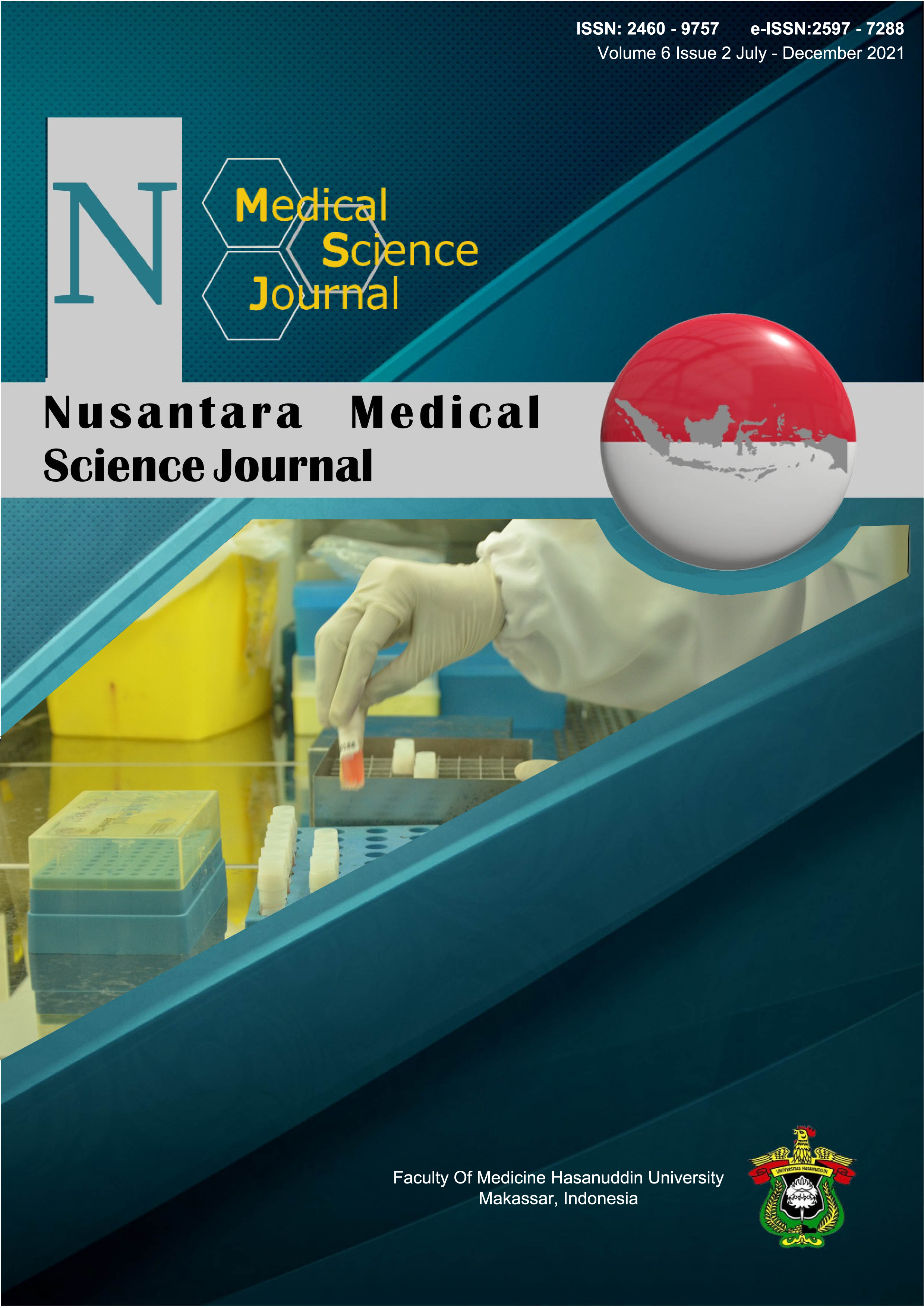Correlation of Rhinomanometry Measurement and True Lateral Radiography towards the Degree of Upper Airway Obstruction in Patients with Adenoid Hypertrophy
DOI:
https://doi.org/10.20956/nmsj.v6i2.18869Abstract
Background: Adenoid hypertrophy is one of the most common disorders in children which may lead to upper airway obstruction. Various modalities to measure airway obstruction in patients with adenoid hypertrophy, including true lateral radiographs, nasoendoscopy, and rhinomanometry are available; however, the results from different studies are still controversial. This study aimed to determine the relationship between the results of rhinomanometry and the true lateral radiographs to the degree of upper airway obstruction in patients with adenoid hypertrophy. Methods: This cross-sectional study included a total of 33 patients with adenoid hypertrophy aged 5-18 years using a purposive sampling technique. Patients diagnosed with adenoid hypertrophy were subjected to a true lateral examination using lateral neck radiographs to measure the degree of airway obstruction. Subsequently, an active anterior rhinomanometry was performed by measuring resistance and nasal airflow and then measuring the degree of airway obstruction. Data analysis was done using Chi-Square test. Results: The rhinomanometric nasal resistance in the inspiratory phase was 0.4159 ± 0.15201 Pa/cm3/s and 0.3694 ± 0.13717 Pa/cm3/s in the expiration phase. The results showed a significant relationship between the true lateral radiographs and both nasal inspiratory (p=0.005) and expiratory resistance (p=0.004). Similarly, the relationship between the true lateral radiographs and nasal airflow on both inspiratory and expiratory rhinomanometry was significant (p<0.05). Conclusion: Rhinomanometric measurements can be used as an additional objective examination in assessing the degree of upper airway obstruction in patients with adenoid hypertrophy prior to surgery.
References
Havas T, Lowinger D. Obstructive adenoid tissue: an indication for powered-shaver adenoidectomy. Arch Otolaryngol Head Neck Surg. 2002;128(7):789-91.
E Soepardi, N.Iskandar. Adenoid Hyperplasia. Buku Ajar Ilmu Kesehatan Telinga-Hidung-Tenggorok Kepala Leher [Otorhinolaryngology - Head and Neck Surgery Teaching Book]. Jakarta: Faculty of Medicine, Universitas Indonesia; 2007.
Mlynarek A, Tewfik MA, Hagr A, Manoukian JJ, Schloss MD, Tewfik TL, et al. Lateral neck radiography versus direct video rhinoscopy in assessing adenoid size. J Otolaryngol. 2004;33(6):360-5.
Zicari A, Magliulo G, Rugiano A, Ragusa G, Celani C, Carbone M, et al. The role of rhinomanometry after nasal decongestant test in the assessment of adenoid hypertrophy in children. Int J Pediatr Otorhinolaryngol. 2012;76(3):352-6.
Soldatova L, Otero HJ, Saul DA, Barrera CA, Elden L. Lateral neck radiography in preoperative evaluation of adenoid hypertrophy. Ann Otol Rhinol Laryngol. 2020;129(5):482-8.
Sharifkashani S, Dabirmoghaddam P, Kheirkhah M, Hosseinzadehnik R. A new clinical scoring system for adenoid hypertrophy in children. Iran J Otorhinolaryngol. 2015;27(78):55.
Aydin S, Sanli A, Celebi O, Tasdemir O, Paksoy M, Eken M, et al. Prevalence of adenoid hypertrophy and nocturnal enuresis in primary school children in Istanbul, Turkey. Int J Pediatr Otorhinolaryngol. 2008;72(5):665-8.
Ren L, Zhang L, Duan S, Zhang W, Zhang Y, editors. Nasal airflow resistance measured by rhinomanometry in a healthy population of China. International forum of allergy & rhinology; 2018: Wiley Online Library.
Kobayashi R, Miyazaki S, Karaki M, Hara H, Kikuchi A, Kitamura T, et al. Nasal resistance in Japanese elementary schoolchildren: Determination of normal value. Acta Otolaryngol. 2012;132(2):197-202.
Kobayashi R, Miyazaki S, Karaki M, Kobayashi E, Karaki R, Akiyama K, et al. Measurement of nasal resistance by rhinomanometry in 892 Japanese elementary school children. Auris Nasus Larynx. 2011;38(1):73-6.
R Eccles. Measurement of the Nasal Airway. Scott-Brown's Otorhinolaryngology Head and Neck Surgery. United States: CRC Press; 2018.
Clement PA, Gordts F. Consensus report on acoustic rhinometry and rhinomanometry. Rhinology. 2005;43(3):169-79.
Vogt K, Jalowayski AA, Althaus W, Cao C, Han D, Hasse W, et al. 4-Phase-Rhinomanometry (4PR)--basics and practice 2010. Rhinology Supplement. 2010;21:1-50.
Lertsburapa K, Schroeder Jr JW, Sullivan C. Assessment of adenoid size: A comparison of lateral radiographic measurements, radiologist assessment, and nasal endoscopy. Int J Pediatr Otorhinolaryngol. 2010;74(11):1281-5.
Downloads
Published
How to Cite
Issue
Section
License
Copyright (c) 2021 Nusantara Medical Science Journal

This work is licensed under a Creative Commons Attribution 4.0 International License.









